Adaptation in Animals Class 4 Notes Science
| Table of contents |

|
| What do we need to survive? |

|
| What is an Adaptation? |

|
| Adaptation for Habitat |

|
| Adaptation for Food Habit |

|
| Special Adaptations |

|
What do we need to survive?
Food, water, and shelter are the basic needs for us to survive.
- Animals also need the same things and they live in places where they can get these.
- The place that provides the basic things for an organism to survive is called its habitat.
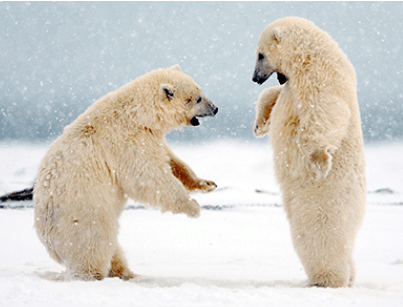 Polar Bear's habitat is on top of the ice that covers Arctic seas
Polar Bear's habitat is on top of the ice that covers Arctic seas
- A habitat is a place where an organism makes its home. A habitat meets all the environmental conditions an organism needs to survive.
What is an Adaptation?
“Adaptation is the physical or behavioral characteristic of an organism that helps an organism to survive better in the surrounding environment.”
- Animals are found in all places or habitats. Some places such as deserts are very hot and dry whereas some places such as Polar Regions are very cold. Some places on Earth have a lot of water, and other places have very little water.
- Not all animals can survive in all places. Camels can live in deserts, but they cannot survive in a cold place.
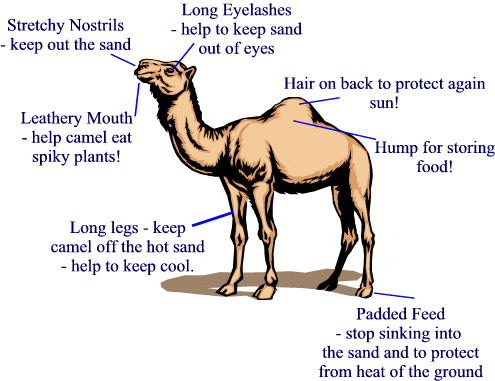 Camels can survive easily in the deserts but they can not survive in cold regions.
Camels can survive easily in the deserts but they can not survive in cold regions.
- Similarly, fish can live only in water and not on land. Animals can live in many different places because they have special features to survive in the area they live in. Fish have gills for breathing in water.
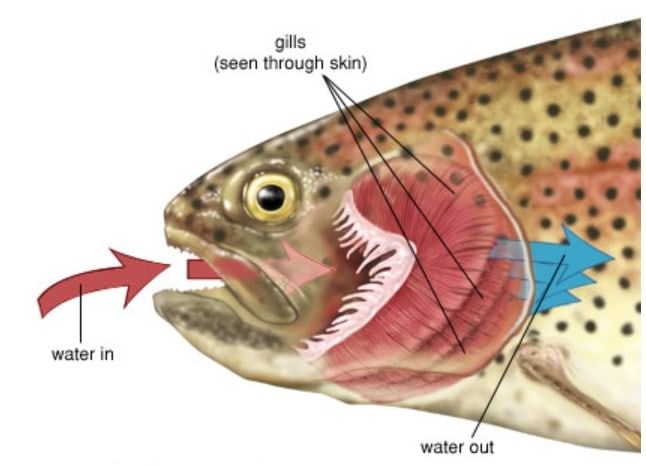 Fish have gills for breathing in water.
Fish have gills for breathing in water.
- Polar bears have thick fur on their body which protects them from cold surroundings in the Polar Region.
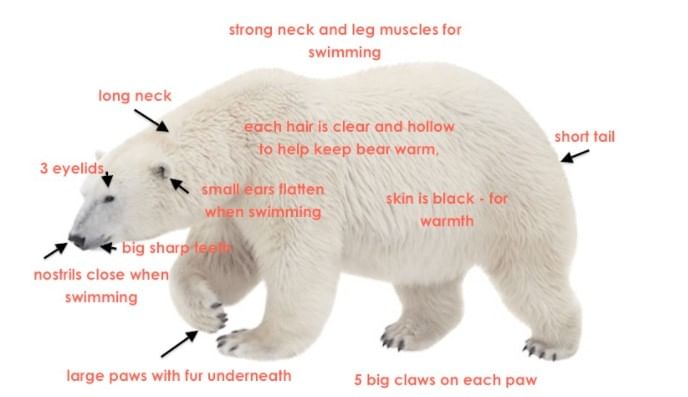 Adaptation Features of Polar Bear
Adaptation Features of Polar Bear
- These special features on an animal’s body are adaptations according to their habitat.
- Sometimes animals also bring changes in their behavior, eating habits, etc. All these changes take place over millions of years.
- The modification or change in an organism’s body or behavior that helps it to survive is called an adaptation.
- When some animals could not change themselves, whole groups of animals died out and became extinct. Thus, in order to survive, animals have to adapt themselves to the changing conditions.
Animals adapt themselves in the following ways:
- For habitat
- For food habit
- For protecting themselves
- For surviving extreme heat and cold
- Special adaptations such as camouflage, migration, and hibernation
Adaptation for Habitat
Animals can be divided into different groups as per their habitat. Let’s take a look at the adaptations in them.
Terrestrial Animals
Animals that live on the land – either on the surface of the ground or in burrows below the surface of the ground are known as terrestrial animals.
- Snakes, rabbits, mice, and foxes live in burrows.
- Dogs, cats, tigers, lions, zebras, cheetahs, elephants, camels, horses, cows live on the open land. Most of them are adapted to live in open lands.
- Their strong legs help them to cover long distances in search of food and water.
- Snakes do not have legs. They have scales in their body that help them to crawl.
- These animals have a well-developed digestive system as per their eating habits.
- Their keen sense of smell, sharp eyesight, sharp teeth, strong legs, claws, and body colour help them to prey on other animals.
 Animals found on Land
Animals found on Land
Adaptation for Surviving Extreme Cold/Polar Regions
- Animals living in cold regions have fur on their bodies to protect them from cold.
- Penguin and polar bears have a thick layer of fat called blubber under their skin to keep them warm.
- Emperor penguins and their chicks huddle together. The birds take turns to occupy the outermost positions. This is an adaptation that helps to keep them warm.
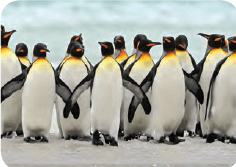 Penguins
Penguins
Adaptation for Surviving Extreme Heat
- Deserts are areas on land that are very hot during the day and very cold at night.
- There is very little food and water because of less rainfall and high temperature.
- Animals living in deserts have thick skin which protects them from the sun. It also prevents water loss from their bodies.
- Scorpion, bandicoot, hedgehog, desert tortoise, kangaroo rat, rattlesnake are some examples of animals living in the desert.
- Some features that help a camel, the ship of the desert, to live in a desert are given below.
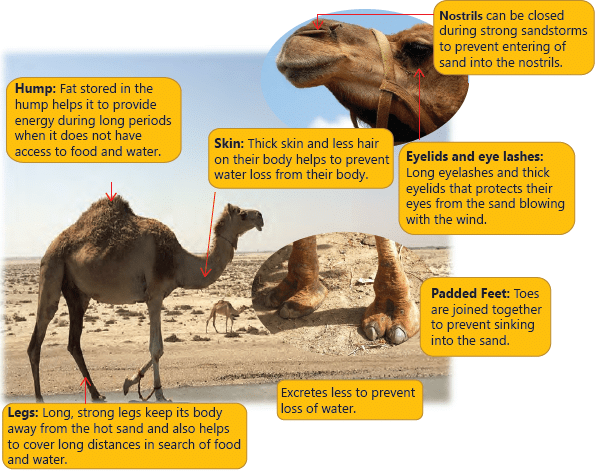
Aquatic Animals
Animals that live in water are called aquatic animals. Crabs, turtles, ducks, fishes, whales, and dolphins are some examples of aquatic animals.
Aquatic animals have different adaptations to help them:
- Most of them breathe through gills. Exceptions like whales and dolphins breathe through the lungs. They come up to the surface of the water for breathing.
- Most aquatic animals have fins or limbs to help them to swim.
- Aquatic birds like ducks and geese have webbed feet which help them to push water back while swimming.
- Streamlined bodies in fish to help them to cut water and move easily.
- Fish have scaly skin. The scales on their skin are waterproof.

Amphibians
Amphibians are animals that can live both on land and in water. Frogs, toads, and newts are some amphibians. They have the following adaptations.
- They have limbs to facilitate swimming. Some of them have webbed feet and tails to help them in swimming.
- They breathe through their moist skin when they are in the water. On land, they breathe through the lungs.
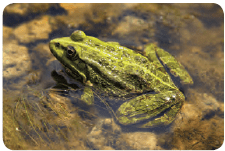 Frog
Frog
Aerial Animals
Aerial animals can fly. Birds, some insects, and bats are examples.
- Their forelimbs are modified as wings to help them to fly.
- They also have feathers that keep them warm and help during the flight.
- Their body is very light as it consists of hollow bones.
- Their body is narrow in the front and at the back and broad in the middle. This streamlined or boat shape helps them to cut through the air and fly easily.
- However, some birds, such as ostrich, kiwi, and penguin cannot fly. They are
known as flightless birds.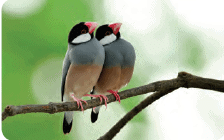 Birds
Birds
Arboreal Animals
Arboreal animals spend most part of their lives on trees. They eat, sleep and play in the tree canopy. Monkeys, koalas, opossums, sloths, and garden lizards are some arboreal animals.
Many animals have special adaptations to aid their arboreal lifestyle.
➤ Limbs and Tails
- Many arboreal animals have long limbs that allow them to swing efficiently from branch to branch.
- Some of them have long tails which can grasp branches and act as an extra limb.
- Spider monkeys, opossums, and chameleons use their tails to move and balance themselves in the tree canopy.
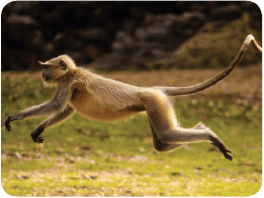 Monkey
Monkey
➤ Feet and Claws
- Animals living in trees like squirrels require a strong grip so that they don’t fall off. They have strong feet and claws.
- Their feet and claws become adapted for seizing, grasping or holding objects by wrapping around them.
- Their fingers and thumb are shaped in such a way that they can hold the branches firmly.
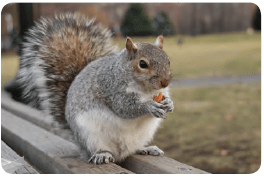 Squirrel
Squirrel
Adaptation for Food Habit
We already learned about the food and feeding habits of animals in the previous class. The type of teeth animals have is an adaptation due to food habits.
- The teeth of herbivores are strong, broad, and flat. They allow them to easily bite and chew the grass and leaves.
- The teeth of carnivores are sharp. They allow them to easily tear the flesh.
- Omnivores have a combination of tearing, biting, and grinding teeth.
- Birds do not have teeth, instead, they have sharp and strong beaks.
- Snakes have powerful muscles which help to swallow and move the food
down the throat.
Parasites
- Parasites are small animals that depend on other living animals for their food.
- Mosquitoes, which suck the blood of humans and other animals, are parasites. Instead of teeth, they have a long sharp pipe.
- They stab animals with this pipe and suck their blood like we drink cold drinks with a straw. Fleas, leeches, and bugs are also parasites.
- They live on the bodies of animals and suck their blood.
- Some parasites such as hookworm, roundworm, and tapeworm live inside the bodies of humans and other animals. They eat the food after it has been digested by the animal.

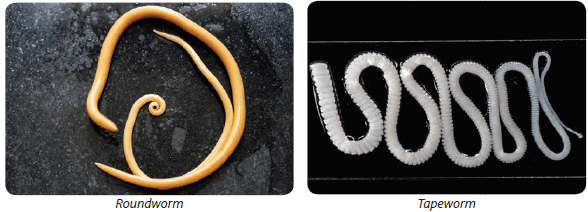
Adaptation for Protecting Themselves
Sometimes, organisms have physical features that help them to remain safe from their predators.
➤ Horns
- Animals like rhinoceros use their horns to push and threaten. Horns are also used by animals for defense.
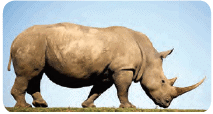 Rhinoceros➤ Scales
Rhinoceros➤ Scales
- Animals such as lizards, chameleons, and snakes have scaly bodies.
- The scales on their skin protect them from drying.
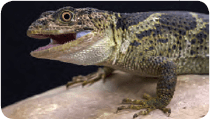 Scales on a chameleon➤ Shells
Scales on a chameleon➤ Shells
- The bodies of garden snails, clams, crabs, and tortoises are covered by a hard shell. The shells help them to stay protected from enemy attacks.
- Garden snails and tortoises can pull their heads, legs, or their whole body inside their shell.
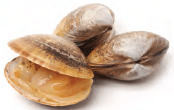 Clams with hard shell
Clams with hard shell
➤ Spines
- Porcupines have spines on the surface of their bodies.
- The spines can injure enemies that go near or attack it. Animals develop various adaptations to protect themselves from being eaten by other animals.
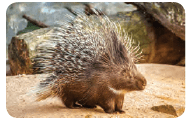 Porcupine with spines
Porcupine with spines
- The ocean has many kinds of fish. Big fish such as sharks eat the smaller fish. A small fish called puff fish protects itself by puffing up like a balloon.
- This makes the sharp spines on its body poke out. The shark cannot eat it.
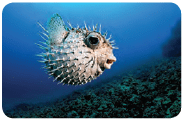 Puff fish with spines
Puff fish with spines
Good to Know
Octopuses, when threatened, release an inky fluid that darkens the water. This confuses the predator. Other examples of animals that release inky fluid are cuttlefish and squid.
Special Adaptations
➤ Camouflage
Camouflage is the ability to blend into the surrounding environment. It is a useful self-defense method for an animal when trying to avoid a predator.
- Chameleons and leaf frogs can change their appearance to match their surroundings.
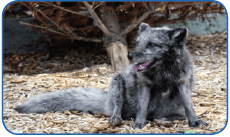 Arctic fox in spring and summer
Arctic fox in spring and summer - The arctic fox can change the colour of its fur to match the colour of its surroundings. In spring and summer, the arctic fox has grey fur. Before the start of autumn and winter, its fur colour changes to white. By changing the colour of its fur, the arctic fox can avoid being detected by its enemies.
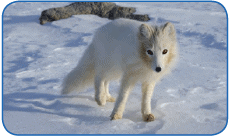 Arctic fox in autumn and winter
Arctic fox in autumn and winter - The stick insect looks like a twig and is difficult to make out when it is sitting on a plant.
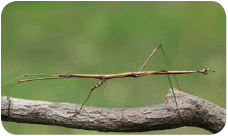 Stick insect on the branch of a tree
Stick insect on the branch of a tree - Zebras, tigers, and leopards have spots or stripes on their bodies that match with their surroundings in the forests. This makes it difficult to see them.
➤ Hibernation
- In habitats that get very cold, animals adapt by sleeping for up to a few months at a time. It is called hibernation.
- During hibernation the animal survives on the stored fat in its body. Bears, chipmunks, hedgehogs, and bats are some animals that hibernate.
 Hibernating bear
Hibernating bear
➤ Migration
- The mass movement of animals and birds from one place to another for breeding, feeding or protecting themselves from harsh weather conditions is called migration.
- Migration is when animals leave their habitat for another one that has better climatic conditions.
- For example, during freezing winter Arctic tern would fly to a warm spot, returning to the original habitat once the weather becomes warmer.
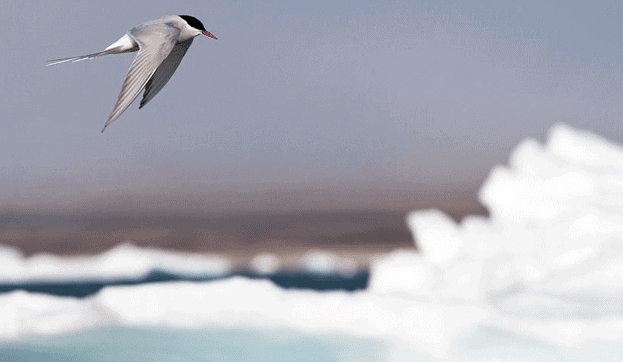 Arctic tern
Arctic tern
- Salmons, whales, swallows, etc. all migrate to far-off places during winter and return as it begins to get warmer.
Good to Know
The Monarch Butterfly migrates from Mexico to Canada each year, but only their babies are able to fly back.
Due to increase in human activities, such as construction of buildings, dams and factories, many animals are losing their natural habitat. This is further causing them to fight hard for shelter and food. Many animals die due to loss of habitat.
Important Points
- The place that provides the basic things for an organism to survive is called its habitat.
- An adaptation is a modification or change in the organism’s body or behaviour that helps it to survive.
- Animals can be divided into five groups according to their habitat—terrestrial, aquatic, amphibian, arboreal and aerial.
- Animals in terrestrial habitat generally have strong legs, well-developed digestive system and sense organs.
- Animals living in cold regions, such as polar bears, have fur on their bodies to protect them from cold.
- Animals living in deserts like camels have thick skin which protects them from the sun.
- Most of the aquatic animals, including fish, live and breathe in water.
- Arboreal animals spend most part of their lives on trees.
- Forelimbs modified as wings, feathers, lightweight bones help aerial animals to fly.
- Parasites are small animals that depend on other living animals for their food.
- Some animals protect themselves through physical features like horn, scale, shell, spine, etc.
- Camouflage is the ability to blend into the surrounding environment.
- During hibernation the animal survives on the stored fat in its body.
- Migration is when animals leave their habitat for another one that has better climatic conditions.
|
53 videos|76 docs|59 tests
|
FAQs on Adaptation in Animals Class 4 Notes Science
| 1. What are the basic needs for survival in animals? |  |
| 2. How do adaptations help animals survive in their habitats? |  |
| 3. Can you give examples of adaptations related to food habits in animals? |  |
| 4. What are special adaptations in animals, and why are they important? |  |
| 5. How do environmental changes affect animal adaptations? |  |
















